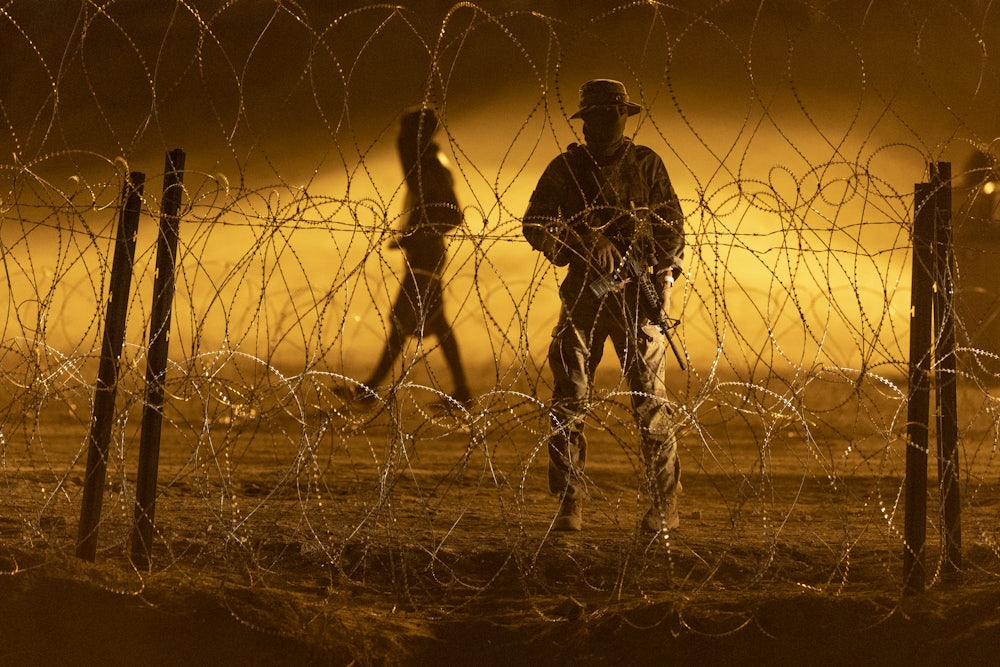As President Donald Trump ridicules Volodomyr Zelenskiy as a “dictator” who spent “$350 billion ... to go into a war that couldn’t be won,” it’s obvious that his administration is shifting resources away from Ukraine, where U.S. aid has been central to helping the country beat back a Russian invasion that began nearly three years ago.
That doesn’t mean that Trump is pulling back from the world, however. U.S. war planners are increasingly focused on containing China in the Pacific. But Trump’s bellicose rhetoric on immigration and his fixation on the southern border are also leading the Pentagon somewhere the military hasn’t gone in over a century: Mexico, where soldiers are already being sent to help the fight against paramilitary drug cartels. Green Berets are currently in the country, training Mexican troops while American drones have been spotted in cartel territory. The American military has quietly but dramatically increased its footprint south of the border in the early days of Trump’s term. If this trend continues, experts fear it could lead to an official U.S. military campaign in Mexico.
Hours after being sworn in, Trump issued an executive order broadly labeling all Mexican drug cartels as Foreign Terrorist Organizations, a move that could lead to direct military actions like drone strikes or even targeted killing missions by American commando units. Two days later, Trump’s Department of Defense sent 1,500 active-duty soldiers to the U.S.-Mexico border.
In late January, civilians using FlightRadar24—an open-source airplane tracking app—spotted RC Rivet Joint aircraft and P-8 Poseidons, which are used to collect imagery and suck up signal intelligence data, flying along the border with Mexico near cartel hotspots. Earlier this week, it was reported that the CIA was using MQ-9 “Reaper” drones, a war on terror staple that can be armed with missiles, on spy missions deep inside of Mexican airspace to tail cartels.
Now the U.S. Special Operations Command, or SOCOM, which oversees the most secretive and elite military units in the country, has confirmed to The New Republic that some of its soldiers are currently training Mexican troops on Mexican soil.
Reports first emerged earlier this week via the Mexican government and social media account that 10 American soldiers in the U.S. Army’s 7th Special Forces Group (widely known as the Green Berets) were in Mexico on a training mission at a naval base in Campeche on the Gulf coast. Some speculated that the soldiers were there to carry out offensive missions on cartels, though representatives insist there is nothing nefarious happening.
“The security cooperation training focuses on enhancing interoperability, strengthening regional partnerships, and improving mutual readiness to address shared security challenges,” a representative from SOCOM told The New Republic in an emailed statement. “For operational security we will not provide the composition of or the identity of the individuals on this mission or the duration of the training.”
For its part, the Pentagon did not publicly disclose the training, which SOCOM was quick to downplay. “This is part of normal routine, pre-planned military training with the Mexican Marine Infantry as part of long-standing U.S.-Mexico defense cooperation,” it said, but did not clarify if it was geared towards countering narco traffickers or when it was ordered. SOCOM added the training fell under a general agreement with Mexico to build its military capabilities.
The Green Berets, however, have a long history of being sent to train allied forces on missions in the lead-up to the outbreak of war.
In October 2001, Green Berets were deployed to Afghanistan, where they fought on horseback with the Northern Alliance against the Taliban, becoming some of the first U.S. soldiers on the ground in what would quickly become the war on terror. Ukrainian special forces sources have confirmed that American trainers were drilling them, long before Russia’s February 2022 invasion, while a retired Green Beret has claimed it was his famed unit working with the country’s military.
Lucas Webber, a senior threat intelligence analyst at Tech Against Terrorism and a research fellow at the Soufan Center, has been closely following the Trump administration’s evolving policies against the cartels. “The designation of cartels and criminal organizations as Foreign Terrorist Organizations frees up more tools to disrupt and counter the financing and operations of these groups and may signal coming escalation,” Webber told The New Republic. “What form this will take is uncertain, but the combination of bellicose rhetoric and the marked increase in intelligence and security resources allocated to Mexico could very well lead to something resemblant of mission creep.”
The Pentagon is arguably as focused on Mexico as it is on China. On a call with his Mexican counterpart earlier in the month, Secretary of Defense Pete Hegseth highlighted, “the importance of Mexico’s armed forces continuing to disrupt cartel activities that threaten the United States.”
If the Mexican government were to step up military actions against the cartels, it’s possible that American troops would be deployed as well. Regardless, Webber believes that escalation is practically inevitable. “The comparatively more aggressive policies towards cartels align with Trump’s stated prioritization of domestic security issues, and it is likely that further intelligence and military options will be explored as time goes on,” he said.
Meanwhile, on Wednesday, Trump made unilateral U.S. action more likely by placing the Sinaloa, Jalisco, Michoacan, and other major regional narcotics-trafficking cartels on the official list of designated terrorist organizations.
Elon Musk, who dictates much of the Trump administration’s policy as head of the so-called Department of Government Efficiency, giddily laid out the stakes on Wednesday: “That means they’re eligible for drone strikes.”
